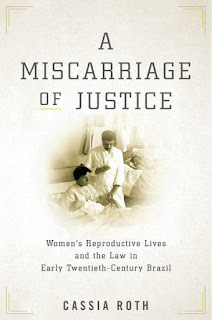 Postdoctoral Research Fellow in the School of History, Classics, and Archaeology at the University of Edinburgh, and a Fulbright Postdoctoral Scholar at the Fundação Oswaldo Cruz in Rio de Janeiro, Brazil.
Postdoctoral Research Fellow in the School of History, Classics, and Archaeology at the University of Edinburgh, and a Fulbright Postdoctoral Scholar at the Fundação Oswaldo Cruz in Rio de Janeiro, Brazil.Roth applied the “Page 99 Test” to her new book, A Miscarriage of Justice: Women’s Reproductive Lives and the Law in Early Twentieth-Century Brazil, and reported the following:
Page 99 includes the stories of two women – Maria Campos de Azevedo and Maria Luisa Bessa – both of whom died due to abdominal infections (peritonitis). Azevedo had delivered her infant at home under the care of an unlicensed midwife. Bessa had sought out an illegal abortion, and the unlicensed provider perforated her uterus. The page both highlights the precarious nature of reproductive healthcare in early twentieth-century Rio de Janeiro and how the illegality of abortion made it deadly to women.Visit Cassia Roth's website.
On the one hand, page 99 centers the embodied experiences of Brazilian women – a central methodological and theoretical tenet of the book. In the introduction, I state that the book is a feminist history of reproduction that centers the lives and deaths of Brazilian women in its historical narrative. To write a feminist history of reproduction, we must emphasize women’s experiences, and this page is a good example of how to do that. On the other hand, page 99 is more focused on medical history than legal history. Overall, the book combines both to make its central argument: that political changes after the end of slavery (1888) and the onset of a republican government (1889) forced all women’s reproductive lives, but particularly those of poor women, into regimes of legal and medical institutional regulation.
Nevertheless, my discussion on page 99 of how the police responded to the unlicensed midwives who provided care to Azevedo and Bessa demonstrate the interconnected nature of legal and medical control over women’s reproductive lives. Readers will get a good feel for how the rest of the book reads; that is, the way I use women’s stories to make larger analytical points, but the page gives the impression that this is simply a medical history, which it is not.
--Marshal Zeringue